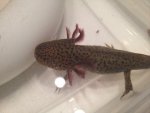Sylerwin
New member
So, it's always been when my axolotls were in their 40 gallon, their color sort of "pales". It's just color. When I revamped their tank I had them in a large tub for a few weeks with daily water changes. My wild type appeared to lighten to a cool light green with spots and red gills. My leucistic went to a cool yellow-ish color with red gills. I was pleasantly surprised. Anyway, after their tank was ready and cycled, I put them in their new home. Since then, their color isn't nearly as vibrant. The wild type darkened, and his gills now appear a dark green. The leucistic is just pale looking. Could it be that in the tub they didn't have an air stone, and now they have a lot of aeration? Or think it's something else? Maybe the filter is stressing them, I need to get a big enough rubber band (my old one broke) to put a shower poof over the water outflow to slow the flow. The ammonia might be a touch high, I had to skip their regularly scheduled water change because I had an emergency in another tank and used the water. Water is now sitting in a bucket dechlorinating. Also, as I was taking pictures, it looks like my leucistic's gills aren't as fluffy. Could that also be all the aeration in the tank? My wild's gills are still plenty fluffy. Ideas?
Photos: (note, light was only this bright for sake of photos, it's usually really dim.)
Their tank
Wildtype with bright color while in the tub
leucistic a few days ago, bright(ish) gills
now- wildtype dark
now-leucistic pale and thinning gills
Their appetite is fine, they get red wigglers every other day, they're getting to where I'll bump them up to one a day though (they've grown so much in the past year!!!)
Substrate is sand, I don't think they're ingesting it because I have them swim up for the worms, so they grab them above the sand bed and practically swallow them whole. Temp is 62F.
I have to run to class but if needed I'll test the water later.
Thanks guys.
Photos: (note, light was only this bright for sake of photos, it's usually really dim.)
Their tank
Wildtype with bright color while in the tub
leucistic a few days ago, bright(ish) gills
now- wildtype dark
now-leucistic pale and thinning gills
Their appetite is fine, they get red wigglers every other day, they're getting to where I'll bump them up to one a day though (they've grown so much in the past year!!!)
Substrate is sand, I don't think they're ingesting it because I have them swim up for the worms, so they grab them above the sand bed and practically swallow them whole. Temp is 62F.
I have to run to class but if needed I'll test the water later.
Thanks guys.





